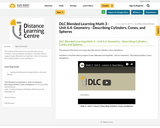
Students must calculate the volume of a cone in this real world task.
- Subject:
- Math
- Material Type:
- Activity/Lab
- Provider:
- Illustrative Mathematics
- Provider Set:
- Illustrative Mathematics
- Author:
- Illustrative Mathematics
- Date Added:
- 05/01/2012

Students must calculate the volume of a cone in this real world task.

The purpose of this lesson is to name, describe and sort cylinders, cones and spheres.
Included is a YouTube video to support Grade 3 Blended Learning Math - Unit 6.4: Geometry - Describing Cylinders, Cones and Spheres.

The purpose of this task is to give students practice working the formulas for the volume of cylinders, cones and spheres, in an engaging context that provides and opportunity to attach meaning to the answers.

This task gives students an opportunity to work with volumes of cylinders, spheres and cones. Notice that the insight required increases as you move across the three glasses, from a simple application of the formula for the volume of a cylinder, to a situation requiring decomposition of the volume into two pieces, to one where a height must be calculated using the Pythagorean theorem.

This lesson describes the function and components of the human nervous system. It helps students understand the purpose of our brain, spinal cord, nerves and the five senses. How the nervous system is affected during spaceflight is also discussed in this lesson.

Ms. Whicker uses similar figures, 3D views and cross-sectional views to have her students construct figures using manipulatives.